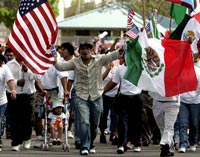Last Sunday, a 28-year-old man was attacked in the city of Potsdam (near Berlin) by racist thugs and violently beaten to a pulp, simply because he is black. This racist attack has prompted a fair amount of outrage and analysis, but also some rather telling statements, like the one from Minister of the Interior Schäuble, insisting that it is “not clear” why the man was attacked, and that “blond, blue-eyed people also can be victims of violence, and sometimes the perpetrators are foreigners” and that that’s supposedly just as bad.
Bullshit!
There is absolutely no question about why this guy was attacked. The Brandenburg police has posted an audio recording (ge) of the attack, which, they hope, will help identify the attackers. As he was attacked, the man recorded the attack with his cell phone to his wife’s voice mail. This chilling recording clearly documents the racist motif of the attack. The attackers can be clearly heard repeatedly calling their victim “nigger” and taunting him. Then they proceeded to bludgeon the poor guy almost to death.
Germany has a real problem. Not just an image problem – a Nigerian delegation cancelled their trip to Potsdam, when they heard the news about the beating. No, Germany has a racism problem. Part of this problem is a legacy of the East German Stalinists. Ironically, despite the fact that Anti-fascism was one of the big slogans of the Worker’s and Farmer’s State, racism is a huge problem (ge) in Germany’s eastern states. Just ask Adebowale Ogungbure (en) a player for the soccer club FC Sachsen Leipzig, who suffers from racist abuse on a regular basis.
Yet, the problem exists all over Germany. Germany’s star national soccer player Patrick Owomoyela had to get a court injunction against a neo-nazi party, the NPD, to stop their recruiting campaign during the Worlcup, which was supposed to prominently feature his white No. 25 national team jersey with the slogan “White, not just a jersey colour for a real national team!”
Jerks!
I have seen it first-hand how this racism permeates German mainstream life. Growing up in Stuttgart, I sometimes hung out with one of the two or three black kids in my high-school. He always had to carry his ID around, because he’d always get his ID checked, especially going downtown. Cops would just walk up to him and demand to see his ID – for no good reason. And he even had a thick Swabian accent for chrissake! And as heinous as the violent racist attacks are, it’s this racist attitude that permeates German culture so deeply, that is the real problem, because it foments the open racism and tolerates the violence.
What to do?
There are many Germans who fight racism. It will be a long, long battle. I think personal contact is the only real cure for racism. So everyone, not just Germans, should look at their community and find ways to build bridges between people. If you live in a place with a strong minority/majority division, seek out those who look or talk different in your neighborhood and invite them to your place. Listen to them, try to see through their eyes. It’s worth the effort. Get your children together – they are your only hope.
The real change has to start with you. So many of our so-called leaders have their heads firmly planted in the sand about this issue. Far too many think that multiculturalism has failed, and far too many think that there has to be a “dominant culture” (Leitkultur) and everyone has to integrate. That’s nonsense, cultural diversity is a good thing and if you open up to it, you will see why.


 For many citizens of Togo, this must be a bittersweet day. On April 27, 1960, the French administered UN Trusteeship and former French colony became an
For many citizens of Togo, this must be a bittersweet day. On April 27, 1960, the French administered UN Trusteeship and former French colony became an 

 I have always liked Guinness, especially on tap. A nice, cool pint of Guinness slows things down a bit, as you watch it slowly settle to its characteristic dark stillness, with this creamy, meditative – but confident – head.
I have always liked Guinness, especially on tap. A nice, cool pint of Guinness slows things down a bit, as you watch it slowly settle to its characteristic dark stillness, with this creamy, meditative – but confident – head.


 Last weekend my dad visited us and since we were doing a bit of sight-seeing, I figured a trip over to Chapel Hill would be fun. I had not visited my alma mater in a long time and this time of year the old campus at UNC is just gorgeous (despite a huge amount of construction everywhere).
Last weekend my dad visited us and since we were doing a bit of sight-seeing, I figured a trip over to Chapel Hill would be fun. I had not visited my alma mater in a long time and this time of year the old campus at UNC is just gorgeous (despite a huge amount of construction everywhere). Pretty day too – even the sky was Carolina Blue!
Pretty day too – even the sky was Carolina Blue!
